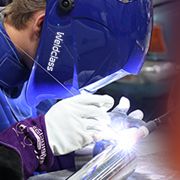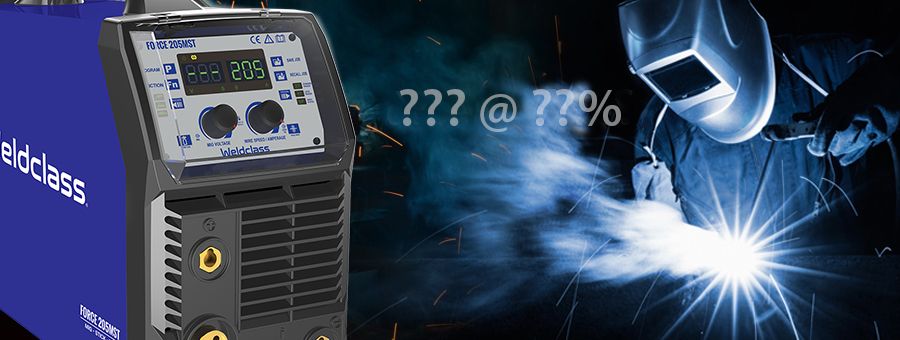Welding Machines - What is Duty Cycle & How is it Calculated
What is Duty Cycle?
Duty cycle is the percentage of time that a machine will safely operate (or weld), within a certain time period, at a given amperage. For example the FORCE 205MST multi-function welder has a duty cycle of 200 Amps @ 30%. This means that it will operate at 200A for 3 minutes within a 10 minute time period. For the remaining 7 minutes, the machine will switch to thermal overload to cool down.
All welding machines are (or should be) fitted with thermal overload protection which means the machine will cut out when internal critical components reach a certain temperature, to prevent damage. The machine will then re-start when it returns to a safe temperature.
Duty cycle will change at different amperages. At higher amperage output the machine will heat up more rapidly, and the duty cycle will reduce. At lower amperages, the duty cycle will increase.
For example - if we look at the 205MST machine again;
Duty cycle at 200 amps = 30%
Duty cycle at 145 amps = 60%
Duty cycle at 110 amps = 100%
How is duty cycle calculated and tested?
While the basic formula is always the same (% of "on" time within the test period), there are several variables which can influence the outcome of a duty cycle test, including:
- Time period over which it is measured (generally 5 or 10 minutes – a 10 minute period is more demanding).
- Ambient temperature in which the test was made (a higher ambient temperature is more demanding).
- Whether the test was with a 'fresh’, cold machine or a machine that was already warmed up from prolonged use. (Testing a machine that is already hot is obviously much more demanding on its cooling system.)
The most widely accepted standard for testing and determining duty cycle ratings is the European Standard EN60974-1, on which the Australian standard AS60974-1 is based. This standard is very demanding and is therefore considered to be the best indication of how a machine will perform in ‘real life’ conditions. All welding machines by Weldclass are tested to this standard.
Again, take the example of the 205MST with a duty cycle rating of 200A @ 30%. To achieve this rating under the EN60974-1 standard, firstly the machine was ‘warmed up’ prior to testing by welding continuously to cause it to cut out on thermal overload at least twice. Then it was tested in a controlled chamber heated to 40◦C. Over a 10 minute period it was then able to weld at 200 Amps (which on this machine is maximum output) for a total of 3 minutes... hence the duty cycle rating of 200A @ 30%.
Are all welding machines duty-cycle tested in the same way?
Unfortunately not all machines are tested to the EN/AS60974-1 standard and therefore it can be difficult to compare the duty cycle ratings of some machines versus others. For example, if the test on the Weldforce WF-200MST was conducted over only 5 minutes and/or with a cold machine and/or at a lower ambient temperature, the rating may well have been 200A @ 50-60% which would be unrealistic and misleading.
All welding machines by Weldclass are duty cycle tested according to EN/AS60974-1 which means that the quoted duty cycle ratings accurately represent how each machine will perform in ‘real life’ conditions.
Is Duty-Cycle the best way to judge the performance of a welding machine ?
Yes and no!
Duty cycle rating - providing that it is accurate and not over-rated (as is sometimes the case) - is a useful indication of how a welding machine will perform in terms of output and capacity (or productivity).
However, duty cycle should not be considered in isolation.
Just as you would (normally) not make a decision to purchase a motor car based only on it's top speed (say without considering aspects like handling, acceleration, safety, etc).... in the same way, there are other factors to be considered when it comes to welding machines.
Firstly, the welding process itself can alter the importance of duty-cycle. Having a higher duty cycle can be important for MIG welders, but may be less important for Stick/MMA and TIG. See further information on this below.
The subject of power draw, power supply and the efficiency of the welder also add another dimension to the duty-cycle subject.
This is especially the case with single-phase (240V) welding machines, where the machine (according to the AS60974-1 standard) must have an effective input current draw (I1eff) equal to or less than than the rated power supply that the machine is designed to operate on - commonly either 10A or 15A.
Often, this requirement is the restriction (or "ceiling") on duty-cycle, more so than what the machine is actually capable of. For example the FORCE 180MST MIG welder, has a duty cycle of 10% at maximum output of 180A. Whilst this machine could easily be disigned to capable of higher duty-cycle, this would make it unsuitable / non-compliant with requirements for use on 10A power supply.
This is why machines with greater efficiency offer an advantage (especially 240V 10A/15A single phase machines). Through greater efficiency they can deliver a higher output and duty cycle, from the same level of power input.
The following machines by Weldclass incorporate "PFC" technology, which greatly increases efficiency and gives them a higher duty cycle; FORCE 205MST, 255MST & 290MST MIG/Stick/TIG welders, and FORCE 45P Plasma Cutter.
The importance of Duty Cycle in different welding processes
While duty cycle is never "un-important", different welding processes will place higher or lower demands on the welding machine in terms of productivity or duty cycle.
The following comments are from a 'rule of thumb' perspective and may be a guide on how much emphasis to place on duty cycle ratings - vs other factors and features - when chosing a suitable welding machine.
Please note that every application is different and the general comments here may not always apply to your situation.
Duty Cycle & MIG Welding
Being an automatic process (eg the wire filler metal is fed automatically), a MIG operator has the ability to weld for long periods of time with minimal "off" or "down" time between welds.
Of course this varies from one application to another.
In production situations, for example where jigs may be used to minimise set up & maximise "welding time", duty cycle can be very important. When it comes to selecting the right welder, opting for a welder that has "too much" capacity, rather than "just enough" is a wise decision. For example, your application may involve production welding of up to 8mm steel. In theory a 200 amp welder, such as the 205MST is capable of this, however in a production situation higher capacity machines like the 255MST or 290MST will offer more duty cycle. (At 200 amps, the 255MST has almost twice the duty cycle of the 205MST).
In maintenance applications, duty cycle may not be so critical, because "welding time" % is typically lower. Often the operator may run just 1 or a few welds before having to do other tasks prior to resuming their next weld.
Duty Cycle & MMA (stick) welding
Because MMA/stick welding is a very manual process - involving changing electrodes, chipping slag, etc - the % of time that the operator spends actually welding is typically a lot lower than MIG. This means that duty cycle is normally not as critical as it may be for MIG.
From this aspect - a duty cycle of 30% (in the case of MMA) could be considered to be "high". For example the FORCE 135ST is the smallest MMA/stick machine in the Weldclass range (140 amps max output), but with a duty cycle of 90A @ 60% it has enough power to run regular 2.6mm electrodes almost non-stop and will also easily run a 3.2mm electrode.
Exceptions to this - stick/MMA applications that require very high duty cycle - can include hard-facing, where each electrode is run in quick succession with very little "time out".
Duty Cycle & TIG welding
When it comes to TIG, the importance of duty cycle can vary considerably.
TIG is commonly used for detailed work on thinner materials and/or smaller parts. In this case, the machine will often never even come close to reaching it's duty cycle limit... and indeed a lot of welding is done at low amperage where the machine may have a duty cycle of 100%. Also, because TIG is a manual process (where the filler metal is fed by hand), the "welding/on time" vs "off time" ratio is lower (compared to MIG).
However, there are some TIG applications where a high duty cycle becomes very important. One example of this is TIG welding of pipe joints where a long, continuous weld is required.
More articles on inverter welders
What is an inverter welder & how does it work?
Using Generators to power Inverter Welders
What is Hot Start, Arc Force & Anti-Stick?
While all care has been taken, Weldclass accepts no responsibility for any inaccuracies, errors or omissions in this information or links and attachments. Any comments, suggestions & recommendations are of a general nature only and may not apply to certain applications. It is the sole responsibility of the user and/or operator to select the appropriate product for their intended purpose and to ensure that the product selected is capable of performing correctly and safely in the intended application. E.&O.E.
-
Thanks for the education. You actually made it simple and easy to understand.Date: 19-02-2021Issifu Yeboah First Klass Refrigeration -
Hey thanks for posting this useful tips here 43 welding machines what is duty cycle how is it calculated, I really hope it will be helpful to many..Appreciative content!!Date: 17-12-2020Metal Fabrication Auckland -
Thanks for simplifying duty cycle, it was a little confusing for me but I learned here. I am sure, a new welder will surely get benefited from such posts!Date: 30-10-2020Anita WelderReview.com -
Thanks for letting me know the calculation of Amperage, I was not aware of this really. Since I'm learning welding related stuffs so these QAs will be very helpful to me.Date: 29-10-2020Anita WelderReview.com




